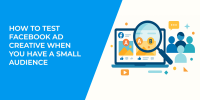Understanding your audience is everything in advertising. You can’t hit the target if you don’t know what you’re aiming at — and in 2025, guessing just isn’t good enough.
So, how do smart advertisers stay ahead?
They listen. Not just to what people say, but to what they do.
Let’s talk about how to build high-impact buyer personas for Facebook Ads using engagement data — the kind of data that tells you what clicks, comments, and shares really mean.
What Is Engagement Data and Why Does It Matter?
When users interact with your ads or organic content — liking, sharing, clicking, saving, or even hovering — they’re giving you a trail of clues.
That’s engagement data. And it’s much more honest than demographic targeting alone.
Rather than relying on broad age ranges or generic interests like “technology,” you get insight into real behavior. It’s like watching your audience in action rather than reading their resume.
Here’s why that matters:
-
Facebook’s ad targeting options have changed dramatically since 2022 — and 2025 isn’t slowing down.
-
Third-party data is drying up. First-party engagement is gold.
-
Behavioral data helps you target users based on intent, not just identity.
Let’s build smarter buyer personas using this goldmine.
Engagement tells you a lot, and tracking the right engagement metrics on Facebook can mean the difference between wasted spend and a high-performing campaign.
Step 1: Map Out Key Engagement Signals
Before you build personas, define what engagement really looks like for your brand. Not every like or comment holds the same value.
Start by tracking:
-
Ad clicks — Which products or content are users drawn to?
-
Video views — Are they watching your content all the way through?
-
Post saves or shares — What content are they keeping for later or passing along?
-
Page follows or profile visits — Who wants to keep tabs on your business?
-
Comment sentiment — Are people excited, curious, skeptical?
Noticing patterns here? That’s where personas start to take shape.
For example: If users who save product-focused reels also click through to pricing pages, they might be your high-intent, budget-conscious shopper.
That’s one persona. But don’t stop there.
Step 2: Segment Your Audience by Behavior, Not Just Demographics
Age, location, and gender still matter — but they don’t tell the whole story.
Behavioral segmentation lets you group users based on what they do, not just who they are.
Try breaking your audience into types like:
-
The Scrollers — View content, rarely click. Low intent, but high reach.
-
The Researchers — Watch full videos, read comments, click on Learn More.
-
The Ready-to-Buy Crowd — Click straight to checkout or landing pages.
-
The Advocates — Like, share, and tag friends. They do your marketing for you.
Notice anything? These aren’t defined by age or job title. They’re defined by actions.
By watching what people engage with most, you can assign each persona its own journey and its own ad creative.
If you're not sure how to define who you’re targeting in the first place, this step-by-step guide to defining a target audience breaks it down into clear actions you can follow.
Step 3: Translate Engagement into Motivations
This is where your data becomes strategy.
Let’s say you have a segment that frequently engages with testimonials and comment threads. They might care most about trust and social proof.
Another group might obsess over product demo videos. They want details and confidence before buying.
Turn these observations into actual buyer personas, like:
-
The Proof Seeker — Needs reassurance from reviews, testimonials, and expert validation.
-
The Curious Clicker — Loves to explore but needs a nudge toward conversion.
-
The Practical Buyer — Prioritizes pricing, features, and comparisons.
Each of these personas demands a different ad experience. That’s how you move from one-size-fits-all to ads that feel personal.
Step 4: Use Custom Audiences to Test Your Personas
Once you’ve built out your personas, it’s time to test.
Facebook’s Custom Audiences are your best tool here. Create audiences based on specific engagement behaviors:
-
People who saved your posts in the last 30 days,
-
Users who viewed 75%+ of your videos,
-
Page visitors who clicked “Send Message”.
Serve each group tailored creative based on the persona you’ve developed. For example:
-
Show in-depth tutorials to your “Researcher” persona.
-
Serve flash sale ads to your “Ready-to-Buy” users.
-
Promote user-generated content to “Proof Seekers.”
Watch the results closely — CTRs, conversions, time on site. Tweak your personas based on what the numbers tell you.
To make the most of this, check out how to set up Facebook retargeting so you can serve the right message to each persona based on what they've already seen or done.
Step 5: Keep Refining with Fresh Engagement Data
Buyer behavior changes. So should your personas.
Make it a habit to revisit engagement trends monthly. Ask yourself:
-
Are new content types generating unexpected engagement?
-
Are certain personas converting better than others?
-
Are you seeing drop-off from once-high-intent users?
Use Facebook Ads Manager’s breakdowns and A/B tests to keep learning. Combine that with insights from Google Analytics, your CRM, or even Shopify behavior.
The more you know, the better you can target — and retarget — your real audience.
Final Thoughts: Personas Built on Data Are Personas That Perform
Building buyer personas used to involve guessing. Now, we’ve got something better — data that reflects real engagement.
By paying close attention to how people interact with your Facebook content, you can move beyond assumptions and create high-converting personas that drive actual results.
It’s not just smart marketing. It’s necessary in a post-tracking world where relevance wins every time.
Want your Facebook ads to work harder? Start with the people who are already talking to you and build from there.

